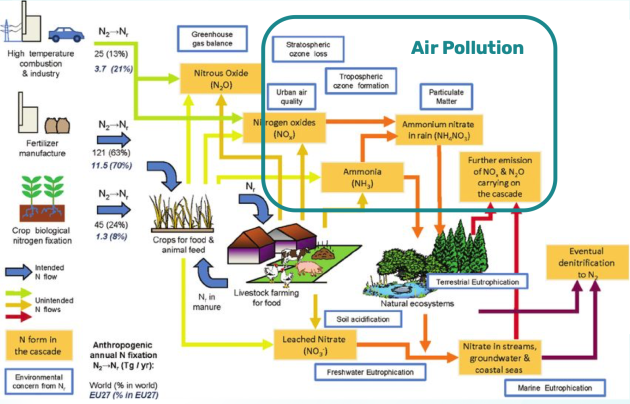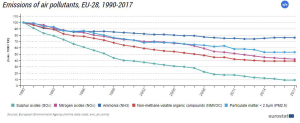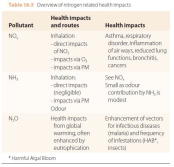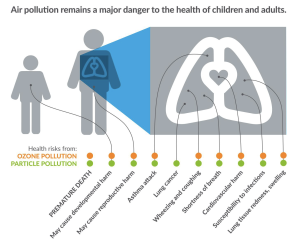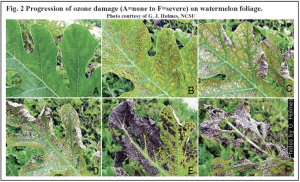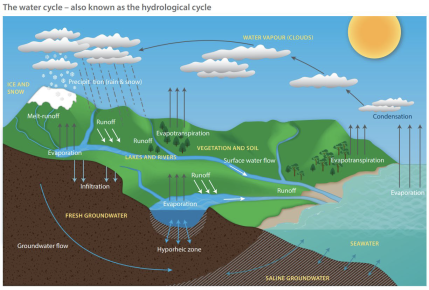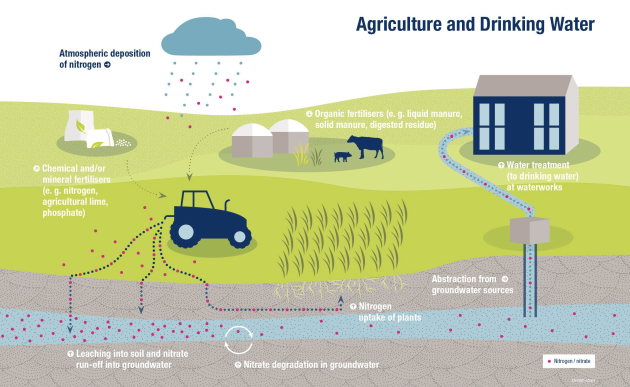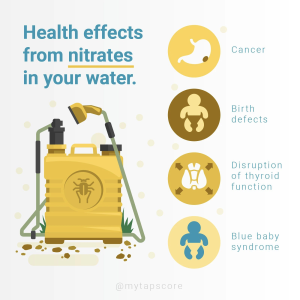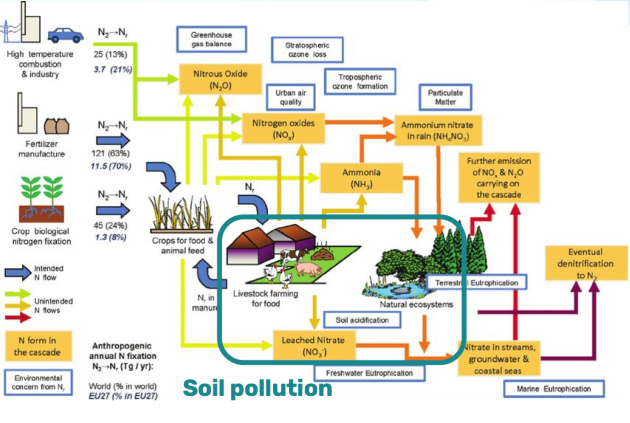Environmental Impacts
The nitrogen cascade
Small reminder :
This cascade of unintentional flows of reactive nitrogen is accompanied by a cascade of harmful consequences for the environment, the climate and human health.
When reactive nitrogen returns in the form of inert atmospheric nitrogen dioxide, it has potentially crossed several compartments in several forms in excessive quantities, and thus contributed to different environmental impacts on all of our planet.
Air pollution
1. Health impacts
Ammonia
NH3 - Health effects of ammonia are indirect through contribution of NH4+ to particulate matter (PM).
Ammonia emissions significantly contribute to the formation of secondary particulate matter in the atmosphere (~ 20% by mass).
The main source of ammonia in the atmosphere is agriculture.
Nitrogen dioxide (NO2)

It is a toxic gas that has adverse health effects both in the long term (chronic) and short term (acute).
Data from Europe suggested that long-term concentrations of nitrogen dioxide or nitrogen oxides (NO) were associated with an increased risk of all-cause mortality.
Nitrogen dioxide is strongly related to particulate matter.
Particulate matter (PM)

NO2 and NH3 - Reactive nitrogen contributes to particle mass and to the adverse health effects caused by the PM.
Ozone
NO2 and NH3 - Reactive nitrogen contributes to particle mass and to the adverse health effects caused by the PM.
Ecosystems
Ammonia
Atmospheric ammonium is absorbed by the leaves of plants. More precisely through the stomata, where gas exchanges take place.
Atmospheric ammonium is absorbed by the leaves of plants. More precisely through the stomata, where gas exchanges take place.
Before reaching the leaf, the pollutant will first have to pass through the “boundary layer”.
Lichens are very affected by atmospheric pollution because they not have a impermeable cuticle.
Lichens and bryophytes are an important part of the ecosystem integrity.
https://www.irishtimes.com/news/science/the-trouble-with-ammonia-1.3721098
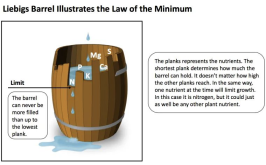
Ammonia acts as a macro-nutrient and at low exposure levels plants respond by increasing their biomass production.
Because plant growth is often limited by the supply of nutrient nitrogen, and so any increases in growth may lead to negative effects on community composition.
The fertilisation effect can at higher exposure levels lead to secondary long-term adverse effects including increased susceptibility to abiotic (drought, frost) and biotic stresses.
Oxides of nitrogen
Oxides of nitrogen can have a fertiliser effect, but can also be toxic to plants, depending on concentrations.
At low concentrations typical of ambient conditions, nitrogen oxides is more phytotoxic than nitrogen dioxide.
As for ammonia, the growth stimulation was also considered as potentially adverse for (semi-) natural vegetation owing to potential negative effects on community composition.
Today ozone is considered to be the most important gaseous pollutant causing effects on vegetation.
Besides visible injuries on leafs and needles, ozone also causes premature leaf loss, reduced photosynthesis and reduced leaf, root, and total dry weights in sensitive plant species.
https://extension.umd.edu/learn/air-pollution-effects-vegetables

Today ozone is considered to be the most important gaseous pollutant causing effects on vegetation.
Besides visible injuries on leafs and needles, ozone also causes premature leaf loss, reduced photosynthesis and reduced leaf, root, and total dry weights in sensitive plant species.
This leads to significant decrease in productivity of some agricultural crops and to reduced forest production.
Effects of ozone on vegetation: from plant cells to ecosystems. [Source: © J.P. Garrec]
Effects on materials

Corrosion of materials was originally mostly associated with air pollution by sulphur dioxide; however know that nitric acid (HNO3), ozone and particulate matter also contribute significantly to the negative effect of air pollution on materials.
The lifetime of technological products is shortened because of air pollution.
Water Pollution
How does nitrogen get into drinking water?
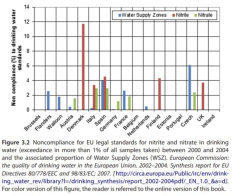
The regulatory level is usually met for public water supplies, which are routinely monitored.
In the EU, noncompliance to the nitrate or nitrite standards in large public supplies is reported regularly but rarely exceeds % of the sample population.
Bryan, Nathan S., et Hans van Grinsven. « The Role of Nitrate in Human Health ». In Advances in Agronomy, 119:153‐82. Elsevier, 2013.https://www.sciencedirect.com/science/article/abs/pii/B9780124072473000032?via%3Dihub
Effects of nitrogen rich drinking water on human health
Eutrophication
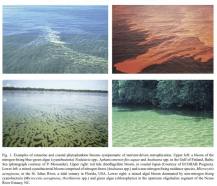
Is one of the most common alterations of continental and marine waters.
Result in an exacerbated productivity of aquatic ecosystems due to an excessive nutrient inputs.
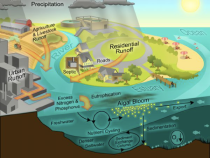
Factors controlling eutrophication can be summed up as a combination of some or all of the following interacting factors:
An excess of nutrients
A long water residence time
A sufficient amount of light
A favourable temperature
Fig. Functional linkages between hydrology, anthropogenic nutrient inputs, eutrophication (phytoplankton blooms), and hypoxia/anoxia
in estuarine and coastal aquatic ecosystems.
Paerl, Hans W. « Assessing and Managing Nutrient-Enhanced Eutrophication in Estuarine and Coastal Waters: Interactive Effects of Human and Climatic Perturbations ». Ecological Engineering 26, no 1 (janvier 2006): 40‐54.

The increase in nutrients leads to a strong increase in primary productivity.
The new limiting factor becomes light.
The light penetration decreasing by self-shading as the biomass produced increases.
Development of more competitive species, which affects a change in primary producer communities, which changes the ecosystem and affects biodiversity.
https://www.unenvironment.org/nowpap/what-we-do/prevent-and-reduce-pollution/eutrophication
Video to watch
Eutrophication and dead zones | Ecology | Khan Academy

A natural eutrophication phenomenon.
The difference between natural and anthropogenic eutrophication is time.
Soil pollution
Soil quality and functions
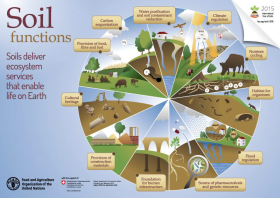
Effect of soil degradation on nitrogen

the effects of soil compaction.
the effects of erosion.
Loss of productivity and sediment accumulating due to erosion sometimes can be seen in the same field as showing in this photo.
Rain enhances the translocation of soil through the process of splashing. Individual raindrops detach soil aggregates and redeposit particles. The dispersed particles may then plug soil pores, reducing water intake. Once the soil dries, these particles develop into a crust at the soil surface and runoff is further increased.
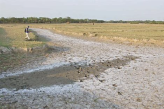
the effects of salinisation.
High salt concentrations inhibit biological nitrogen transformations in soil, as well as nitrogen fixing capacity by legumes.
the effects of soils contamination.

the effect of organic matter decline.
Figure. The vicious cycle of depletion in soil organic matter-decline in
crop yield-food insecurity-soil
Vicente Vicente, José. « Soil organic carbon sequestration in Andalusian olive groves: effect of the managements on soil organic carbon dynamics », 2017.
Effect of nitrogen on soil
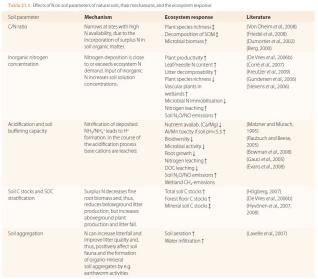
Nitrogen as a threat to biodiversity
What is biodiversity ?
Video to watch :
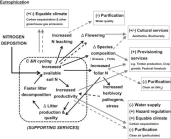
Ecosystems can be defined by both their sensitivity and their
vulnerability to a stress such as enhanced nitrogen deposition.
The major impacts of nitrate deposition on terrestrial ecosystem
diversity are through :
eutrophication,
Fig. 1. Process-based impact pathway for eutrophication. Black arrows indicate process-based links, grey arrows show links to ecosystem services, where + and – indicate the nature of relationship and examples are given in small type. Solid arrows represent positive relationships and dashed arrows negative relationships. The dotted line box encompasses processes linked to C and N cycling (=Supporting Services). Impacts on species composition are generalised to increases in graminoids and decreases in forbs, but in reality are much more complex.
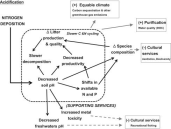
acidification,
Fig. 2. Process-based impact pathway for acidification.
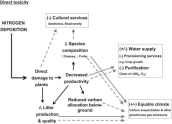
direct foliar impacts,
Fig. 3. Process-based impact pathway for direct toxicity (incorporating NOx and NH3 effects).
exacerbation of other stresses.
Jones, L., A. Provins, M. Holland, G. Mills, F. Hayes, B. Emmett, J. Hall, et al. « A Review and Application of the Evidence for Nitrogen Impacts on Ecosystem Services ». Ecosystem Services 7 (1 mars 2014): 76‐88. https://doi.org/10.1016/j.ecoser.2013.09.001.

Figure. Schematic of the main impacts of enhanced N deposition on ecosystem processes and species richness. Stress is considered to occur when external constraints limit the rate of production of vegetation; disturbance consists of mechanisms that affect plant biomass by causing its partial or total destruction.
Sutton, Mark A., éd. The European Nitrogen Assessment: Sources, Effects and Policy Perspectives. Cambridge: Cambridge Univ. Press, 2011.
Example : Red-backed shrike
Medias
Impossible d'accéder à la ressource audio ou vidéo à l'adresse :
La ressource n'est plus disponible ou vous n'êtes pas autorisé à y accéder. Veuillez vérifier votre accès puis recharger le média.
Impossible d'accéder à la ressource audio ou vidéo à l'adresse :
La ressource n'est plus disponible ou vous n'êtes pas autorisé à y accéder. Veuillez vérifier votre accès puis recharger le média.
